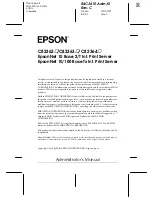
If you change the system and setup password, a message prompts you to reenter the new password.
If you delete the system and setup password, a message prompts you to confirm the deletion.
6.
Press Esc to return to the
System BIOS
screen. Press Esc again, and a message prompts you to save
the changes.
Related Links
Operating with a setup password enabled
If
Setup Password
is set to
Enabled
, type the correct setup password before modifying the system setup
options.
If you do not type the correct password in three attempts, the system displays the following message:
Invalid Password! Number of unsuccessful password attempts: <x> System Halted!
Must power down.
Even after you turn off and restart the system, the error message is displayed until the correct password is
typed. The following options are exceptions:
• If
System Password
is not set to
Enabled
and is not locked through the
Password Status
option, you
can assign a system password. For more information, see the System Security Settings screen section.
• You cannot disable or change an existing system password.
NOTE: You can use the password status option with the setup password option to protect the
system password from unauthorized changes.
Related Links
Memory Settings
You can use the
Memory Settings
screen to view all the memory settings and enable or disable specific
memory functions, such as system memory testing and node interleaving.
Related Links
Memory Settings details
System BIOS
Viewing Memory Settings
Viewing Memory Settings
To view the
Memory Settings
screen, perform the following steps:
1.
Turn on, or restart your system.
2.
Press F2 immediately after you see the following message:
F2 = System Setup
NOTE: If your operating system begins to load before you press F2, wait for the system to finish
booting, and then restart your system and try again.
3.
On the
System Setup Main Menu
screen, click
System BIOS
.
4.
On the
System BIOS
screen, click
Memory Settings
.
Related Links
Memory Settings
Memory Settings details
57
















































